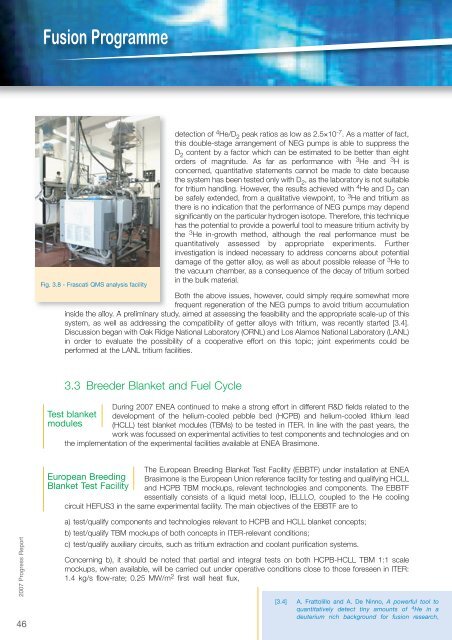Fusion Programme - ENEA - Fusione
Fusion Programme - ENEA - Fusione
Fusion Programme - ENEA - Fusione
- No tags were found...
You also want an ePaper? Increase the reach of your titles
YUMPU automatically turns print PDFs into web optimized ePapers that Google loves.
<strong>Fusion</strong> <strong>Programme</strong>Fig. 3.8 - Frascati QMS analysis facilitydetection of 4 He/D 2 peak ratios as low as 2.5×10 -7 . As a matter of fact,this double-stage arrangement of NEG pumps is able to suppress theD 2 content by a factor which can be estimated to be better than eightorders of magnitude. As far as performance with 3 He and 3 H isconcerned, quantitative statements cannot be made to date becausethe system has been tested only with D 2 , as the laboratory is not suitablefor tritium handling. However, the results achieved with 4 He and D 2 canbe safely extended, from a qualitative viewpoint, to 3 He and tritium asthere is no indication that the performance of NEG pumps may dependsignificantly on the particular hydrogen isotope. Therefore, this techniquehas the potential to provide a powerful tool to measure tritium activity bythe 3 He in-growth method, although the real performance must bequantitatively assessed by appropriate experiments. Furtherinvestigation is indeed necessary to address concerns about potentialdamage of the getter alloy, as well as about possible release of 3 He tothe vacuum chamber, as a consequence of the decay of tritium sorbedin the bulk material.Both the above issues, however, could simply require somewhat morefrequent regeneration of the NEG pumps to avoid tritium accumulationinside the alloy. A preliminary study, aimed at assessing the feasibility and the appropriate scale-up of thissystem, as well as addressing the compatibility of getter alloys with tritium, was recently started [3.4].Discussion began with Oak Ridge National Laboratory (ORNL) and Los Alamos National Laboratory (LANL)in order to evaluate the possibility of a cooperative effort on this topic; joint experiments could beperformed at the LANL tritium facilities.3.3 Breeder Blanket and Fuel CycleDuring 2007 <strong>ENEA</strong> continued to make a strong effort in different R&D fields related to theTest blanket development of the helium-cooled pebble bed (HCPB) and helium-cooled lithium leadmodules (HCLL) test blanket modules (TBMs) to be tested in ITER. In line with the past years, thework was focussed on experimental activities to test components and technologies and onthe implementation of the experimental facilities available at <strong>ENEA</strong> Brasimone.The European Breeding Blanket Test Facility (EBBTF) under installation at <strong>ENEA</strong>European Breeding Brasimone is the European Union reference facility for testing and qualifying HCLLBlanket Test Facility and HCPB TBM mockups, relevant technologies and components. The EBBTFessentially consists of a liquid metal loop, IELLLO, coupled to the He coolingcircuit HEFUS3 in the same experimental facility. The main objectives of the EBBTF are to2007 Progress Report46a) test/qualify components and technologies relevant to HCPB and HCLL blanket concepts;b) test/qualify TBM mockups of both concepts in ITER-relevant conditions;c) test/qualify auxiliary circuits, such as tritium extraction and coolant purification systems.Concerning b), it should be noted that partial and integral tests on both HCPB-HCLL TBM 1:1 scalemockups, when available, will be carried out under operative conditions close to those foreseen in ITER:1.4 kg/s flow-rate; 0.25 MW/m 2 first wall heat flux,[3.4] A. Frattolillo and A. De Ninno, A powerful tool toquantitatively detect tiny amounts of 4 He in adeuterium rich background for fusion research,













